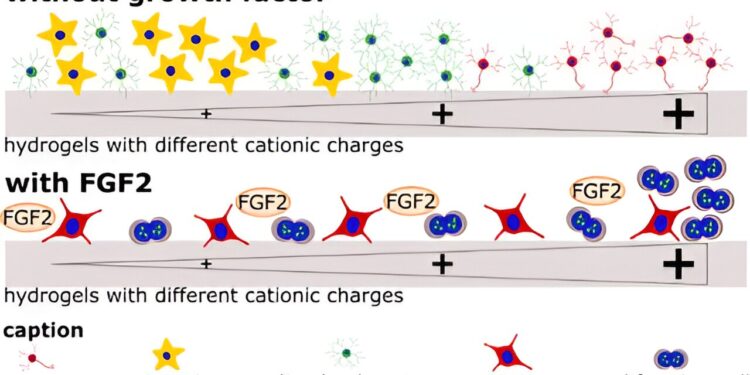Graphical summary. Credit: ACS Biomaterials Science and Engineering (2024). DOI: 10.1021/acsbiomaterials.3c01668
Researchers from Bochum and Dortmund have created an artificial cellular environment that could promote nerve regeneration. Usually, injuries to the brain or spinal cord do not heal easily due to the formation of fluid-filled cavities and scarring that prevent tissue regeneration.
A starting point for medical research is therefore to fill the cavities with a substance offering neural stem cells optimal conditions for proliferation and differentiation. The team from Ruhr University Bochum and TU University Dortmund, both in Germany, showed that positively charged hydrogels can promote the survival and growth of stem cells.
Dr. Kristin Glotzbach and Prof. Andreas Faissner from the Department of Cell Morphology and Molecular Neurobiology in Bochum cooperated with Prof. Ralf Weberskirch and Dr. Nils Stamm from the Faculty of Chemistry and Chemical Biology at TU Dortmund University. They describe the results in the journal ACS Biomaterials Science and Engineering.
Positively charged hydrogels promote survival and differentiation
The researchers studied neural stem cells from embryonic mouse brains, which they cultured on positively charged hydrogels. “Our goal was to create an artificial environment for cells that mimics the natural cellular environment of the brain,” explains Kristin Glotzbach.
“Cells have a negatively charged coating, also called a pericellular matrix. This means that they adhere particularly well to positively charged substrates.” The trick of the hydrogels used in the experiments was that the strength of their positive charge could be precisely adjusted.
As the experiments showed, the positively charged hydrogels facilitated cell survival and affected their future fate. If stem cells adhered to hydrogels with a high positive charge, they tended to develop into nerve cells. In contrast, on gels with a lower positive charge, stem cells primarily developed into glial cells, which serve important auxiliary functions for nerve cells.
The ability to influence the differentiation of stem cells into nerve or glial cells would be a great advantage. “Depending on the injury, different types of cells need to be replaced,” explains Kristin Glotzbach. It’s not just the regeneration of nerve cells that is important.
“In some diseases, glial cells are also attacked and must be replaced. In multiple sclerosis, for example, the insulation of nerve cells, consisting of oligodendrocytes, is destroyed.”
Adding a growth factor improves survival rate
When the researchers added the growth factor FGF2 to the positively charged hydrogels, they were able to increase the rate of cell survival and division. But differentiation into nerve and glial cells then occurred at a slower rate.
“In future studies, we intend to add peptides or components of extracellular matrix molecules to positively charged gels in order to simulate the natural environment of cells even more effectively,” explains Kristin Glotzbach. The researchers also plan to experiment with three-dimensional gels that could fill cavities after brain damage.
More information:
Kristin Glotzbach et al, Cationic hydrogels modulate the proliferation and differentiation behavior of neural stem and progenitor cells depending on the concentration of cationic moieties in 2D cell culture, ACS Biomaterials Science and Engineering (2024). DOI: 10.1021/acsbiomaterials.3c01668
Powered by Ruhr-Universitaet-Bochum
Quote: Scientists show that positively charged hydrogels promote survival and growth of neural stem cells (February 20, 2024) retrieved February 20, 2024 from
This document is subject to copyright. Apart from fair use for private study or research purposes, no part may be reproduced without written permission. The content is provided for information only.



